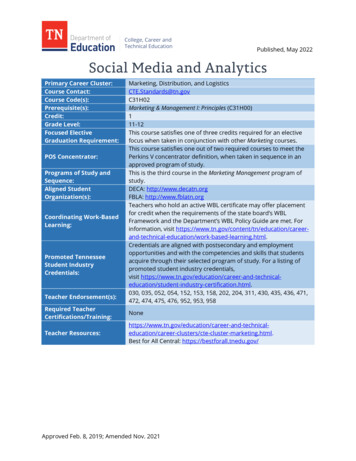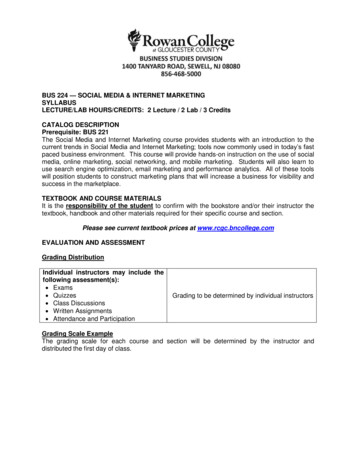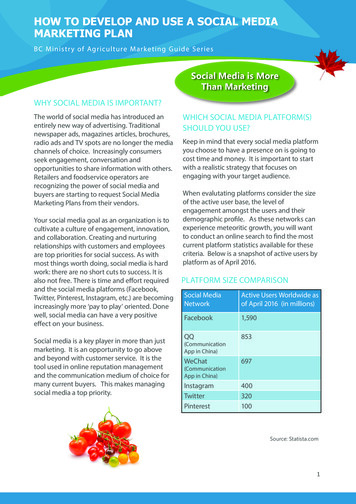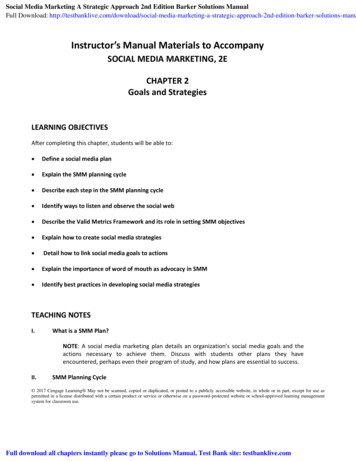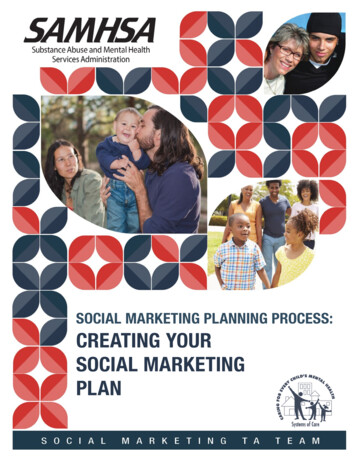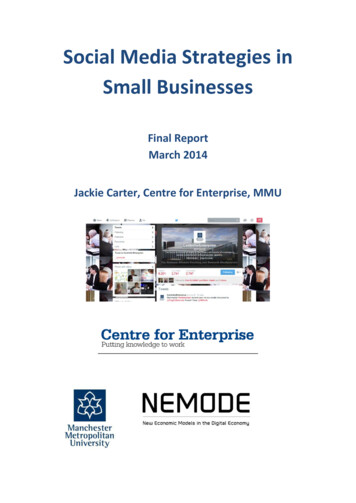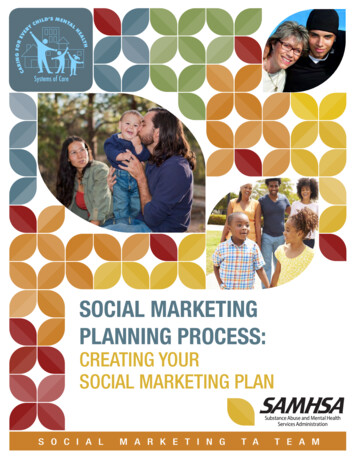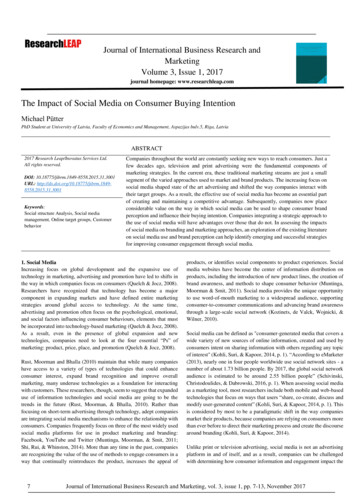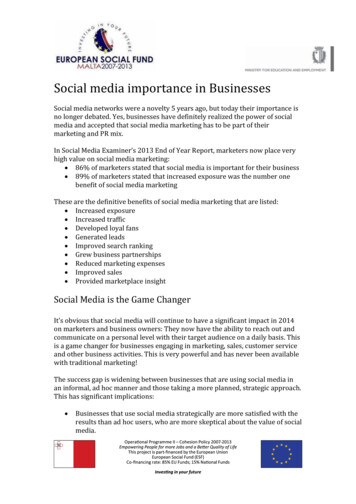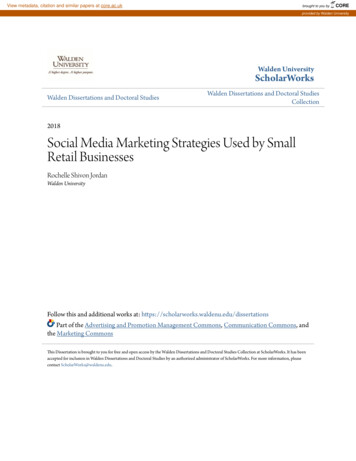
Transcription
View metadata, citation and similar papers at core.ac.ukbrought to you byCOREprovided by Walden UniversityWalden UniversityScholarWorksWalden Dissertations and Doctoral StudiesWalden Dissertations and Doctoral StudiesCollection2018Social Media Marketing Strategies Used by SmallRetail BusinessesRochelle Shivon JordanWalden UniversityFollow this and additional works at: https://scholarworks.waldenu.edu/dissertationsPart of the Advertising and Promotion Management Commons, Communication Commons, andthe Marketing CommonsThis Dissertation is brought to you for free and open access by the Walden Dissertations and Doctoral Studies Collection at ScholarWorks. It has beenaccepted for inclusion in Walden Dissertations and Doctoral Studies by an authorized administrator of ScholarWorks. For more information, pleasecontact ScholarWorks@waldenu.edu.
Walden UniversityCollege of Management and TechnologyThis is to certify that the doctoral study byRochelle Jordanhas been found to be complete and satisfactory in all respects,and that any and all revisions required bythe review committee have been made.Review CommitteeDr. Timothy Malone, Committee Chairperson, Doctor of Business AdministrationFacultyDr. John Hannon, Committee Member, Doctor of Business Administration FacultyDr. James Savard, University Reviewer, Doctor of Business Administration FacultyChief Academic OfficerEric Riedel, Ph.D.Walden University2018
AbstractSocial Media Marketing Strategies Used by Small Retail BusinessesbyRochelle S. JordanMA, Webster University, 2013BS, Northwestern State University, 2005Doctoral Study Submitted in Partial Fulfillmentof the Requirements for the Degree ofDoctor of Business AdministrationWalden UniversityOctober 2018
AbstractDeveloping effective social media marketing (SMM) strategies to engage customers is achallenge for business leaders. The purpose of this multiple case study was to explore theSMM strategies used by small business retailers to engage customers. The conceptualframework for this study was Rogers’s diffusion of innovations theory. Participantsincluded 5 small business retailers who had been in business for at least 5 years, usedeffective SMM strategies to engage customers, and were located in the southwest regionof the United States. Data were collected through semistructured, face-to-faceinterviews. Data analysis resulted in 3 emergent themes: (a) marketing strategies andplatforms, (b) social media content, and (c) customer engagement and retention. Smallbusiness retailers might benefit from the findings of this study by understanding whatother small business retailers consider the most beneficial social media platforms andstrategies, what customers desire in social media content, and effective customerengagement and retention processes to create SMM strategies. The implications forpositive social change could include providing small business retailers with SMM bestpractices and strategies to improve company sustainability and growth, generateemployment, reduce local poverty, and enhance employees’ standards of living.
Social Media Marketing Strategies Used by Small Retail BusinessesbyRochelle S. JordanMA, Webster University, 2013BS, Northwestern State University, 2005Doctoral Study Submitted in Partial Fulfillmentof the Requirements for the Degree ofDoctor of Business AdministrationOctober 2018
DedicationI dedicate this doctoral study to my family, who through their many sacrifices,have made obtaining my Doctorate possible and worthwhile. To my wonderful, smart,and talented daughters, Hope, Faith, and Kenyetta, this accomplishment is a testamentthat you can achieve anything you strive for. To my peers at Walden University,especially Ranelli Williams, I cannot thank you all enough for encouraging methroughout this journey.
AcknowledgmentsI would like to thank my Committee Chair, Dr. Timothy Malone, for hisunderstanding, patience, and support throughout this arduous process. Also, a huge thankyou to Dr. Gregory Banks for guiding me through the very beginning of this journey. Iwould not have made it to this point if not for his constant encouragement and belief inme. I must thank my closest friends who have supported me through thick and thin. I amforever indebted to you for your kind words and motivation that kept me going. I alsowish to thank Drs. Hannon (SCM), Savard (URR), and Davis (Program Director), foryour individual contributions to the development of my study. I would like to thank allof my instructors and the Walden faculty and staff for assisting whenever and howeverthey could to ensure my success. Lastly, but certainly not least, I want to thank myfamily again, for their love and support, for allowing me to pursue my never-endingdesire for higher learning, and for challenging me to be the best version of myself everyday.
Table of ContentsList of Tables . ivTable 1. Participants’ Responses to Themes . ivTable 2. Participants’ Social Media Platforms . ivTable 3. Participants’ Instagram Activity . ivSection 1: Foundation of the Study.1Background of the Problem .1Problem Statement .2Purpose Statement .3Nature of the Study .3Research Question .6Interview Questions .6Conceptual Framework .6Operational Definitions .8Assumptions, Limitations, and Delimitations .9Assumptions. 9Limitations . 10Delimitations . 10Significance of the Study .11Contribution to Business Practice . 11Implications for Social Change . 12A Review of the Professional and Academic Literature .13i
Diffusion of Innovations Theory . 14Innovation . 17Small Business Contributions to the U.S. Economy. 18Social Media . 19Social Media Marketing (SMM) . 20Adopting Social Media Marketing Strategies . 27Benefits of Social Media Marketing . 31Transition .33Section 2: The Project .34Purpose Statement .34Role of the Researcher .34Participants .36Research Method and Design .38Research Method . 39Research Design. 40Population and Sampling .40Ethical Research.42Data Collection Instruments .43Data Collection Technique .45Data Organization Technique .46Data Analysis .47Reliability and Validity .47ii
Reliability. 48Validity . 49Transition and Summary .50Section 3: Application to Professional Practice and Implications for Change .51Introduction .51Presentation of the Findings.51Emergent Theme 1: Social Media Marketing Strategies and Platforms . 53Emergent Theme 2: Social Media Content . 56Emergent Theme 3: Customer Engagement and Retention . 61Applications to Professional Practice .63Implications for Social Change .65Recommendations for Action .66Recommendations for Further Research .67Reflections .68Conclusion .70References .71Appendix A: Interview Questions .109Appendix B: Interview Protocol .110iii
List of TablesTable 1. Participants’ Responses to Themes.51Table 2. Participants’ Social Media Platforms .52Table 3. Participants’ Instagram Activity .56iv
1Section 1: Foundation of the StudyIn 2015, the number of small businesses totaled 28.4 million in the United Statesof America, but 50% of small businesses are likely to fail within the first five years ofoperation (Small Business Administration [SBA], 2015). Small businesses play a vitalrole in creating new jobs, innovations, and economic growth (Karadag, 2015). Socialmedia marketing (SMM) is one strategy that may lead to improved survival of smallbusinesses (Wamba & Carter, 2014). Many small business owners fail to consider digitalmedia when developing marketing strategies (Hassan, Nadzim, & Shiratuddin, 2015).However, there is a paucity of literature related to how social media enhanced businessperformance (Paniagua & Sapena, 2014).The lack of literature on the benefits of SMM and knowledge of organizationalimpacts indicates the need for further research (Charlesworth, 2014). Future researcherscould uncover best practices and effective SMM strategies to help business leadersexploit potential benefits and assess which social media tools and strategies are mostbeneficial to achieve competitive advantage (Boling, Burns, & Dick, 2014; Brooks,Heffner, & Henderson, 2014). Practitioners might benefit from this study by gainingmore insights about the associated risks and benefits of social media and to makeinformed decisions to adopt SMM strategies (Paniagua & Sapena, 2014).Background of the ProblemSmall businesses play a vital role in the global economy. The classification of asmall business in the retail trade industry is a business with a gross of less than 7.5million in average annual receipts that employs 1 to 500 people (SBA, 2016a). Small
2business owners faced marketing challenges to gain a competitive market position(Hutchinson, Donnell, Gilmore, & Reid, 2015). One of the most impactful challenges forbusiness leaders is developing an effective SMM strategy to engage customers (Oyza &Agwu, 2016). Jones et al. (2015) posited that an effective marketing strategy isinvaluable to business success. Effective marketing strategies have a positive impact on abusiness’s financial performance and survival rate (Fillis, 2015).Small businesses must employ certain customer engagement practices to competeagainst larger firms (Taneja & Toombs, 2014). Social media were the most cost-effectivemedium for marketing and suitable for small businesses that may not have a largemarketing budget (Hassan et al., 2015). Some small business leaders lack effectiveSMM strategies required to successfully engage consumers. Herman (2015) posited thatsmall business leaders have been unsuccessful in implementing SMM strategies thatpromote the longevity of their businesses. The high failure rate of small business in theUnited States was a major concern (Anderson & Ullah, 2014; Karadag, 2015). Whilemany factors contribute to business failure, customer engagement is a key component forbusiness success (Hibbler-Britt & Sussan, 2015) as well as setting goals and developingstrategies (Chatterjee & Das, 2015).Problem StatementThere are some organizations struggling to find ways to effectively connect withcustomers (Oyza & Agwu, 2016). Oyza and Agwu (2016) discovered that 62% ofmarketers identified developing an effective social media marketing strategy as one of themost impactful challenges for business leaders. The general business problem is that
3some business leaders do not fully understand how to leverage social media marketing toengage customers. The specific business problem is that some business leaders struggleto effectively implement social media marketing strategies to engage customers.Purpose StatementThe purpose of this qualitative multiple case study was to explore the SMMstrategies small business retailers used to engage customers. The target population wasfive successful small business retailers in the San Antonio, Texas (SATX) region. Thesample was five small business retailers who developed and employed successful SMMstrategies to engage customers. Small business retailers may use the results of this studyto gain insights into using social media and creating successful SMM strategies toeffectively engage customers. The implication for social change is the possible increasein the success rate of existing and future small retail businesses in SATX. Successfulsmall businesses might employ more people, who in turn, could financially stimulate thelocal economy. The money generated by small businesses might increase taxation to helpfund social services.Nature of the StudyThis study is a qualitative, multiple case study. The purpose of a qualitative studyis to explain how and why a phenomenon exists when not enough information on asubject exists (Yin, 2018). Participant observation and in-depth interviews are waysresearchers use qualitative methods to explore a phenomenon (Morse, 2015). Qualitativeresearch involves assembling, organizing, and explaining material derived from dialog orconversation (Grossoehme, 2014). The need to discover what SMM strategies small
4business retailers use to engage customers will drive the methodology of this study.Bryman (2015) posited that quantitative research focused on measurement,generalization, replication, and causality. A quantitative researcher examines therelationships between variables, seeks to answer hypotheses through surveys andexperiments, and tests theories by analyzing statistical data (Yin, 2018). A quantitativemethod does not provide the opportunity to develop a deep understanding of aphenomenon (Spillman, 2014). Researchers prefer qualitative instead of quantitativeresearch to gain a contextual understanding of a phenomenon (Allen, Hancock, &Vardaman, 2014). I examined how perceptions affect individuals’ thoughts and actionswithin a situational context. The mixed methodology was also not suitable for this study.Mixed methods research design combines qualitative and quantitative methods in a singleresearch project where one method strengthens the other to be more effective (HesseBiber, 2015). Two factors for the mixed methods design are the amount of time requiredto complete the study and numerical data (McCusker & Gunaydin, 2014). The mixedmethods approach is a way to take advantage of the benefits both methods offer (Bryman,2015; Morse & Cheek, 2014); however, due to time constraints and a lack of hypothesesto test (see Yin, 2018), a mixed methods approach was not beneficial for this study. Ofthe identified research methods, the qualitative research was the best method for mystudy because I explored the strategies and motivations of small business retailers whosuccessfully used SMM.Grounded theory, ethnography, phenomenology, and case study designs are allqualitative research designs (Ingham-Broomfield, 2015). Phenomenological,
5ethnographic, and grounded theory designs are not suitable for this study because of thecharacteristics and goals associated with each. Grounded theory is a general researchmethod consisting of various research procedures for the development of conceptualcategories (Tossy, 2015). Grounded theory suits qualitative or quantitative research andworks best when exploring the context of a phenomenon (Corley, 2015). Thephenomenological design reflects a participant’s perspective of an event or situationwhile the researcher tries to answer the question of the experience (Gill, 2014).Phenomenological design studies are ideal for exploring intense social, affective humanbehavior and shared experiences of a social phenomenon (Merriam, 2009), which was notthe goal of my research.In ethnographic research, often referred to as the fly on the wall technique, peopleare observed closely in their natural environments (Cayla, Beers, & Arnould, 2014).Ethnographic researchers observe cultures, organizations, and groups closely (Brown,2014). The ethnographic design was not suitable for this study because I did not focus ona specific culture. Researchers used case studies to explore a contemporary phenomenon(Yin, 2018), with the intent to understand the setting or context of an occurrence in realtime (Singh, 2014). Case study designs required face-to-face interviews and allowed theresearcher to receive extensive feedback (Yin, 2018). Case studies also offeredopportunities to answer how and why a phenomenon exists and possibly obtain solutionsto the phenomenon (Yin, 2018). The case study was used to analyze details of real-lifesituations (Ardhendu, 2014) and helped to establish a comprehensive and completeunderstanding of the business problem.
6Research QuestionWhat SMM strategies do small business retailers use to engage customers?Interview Questions1. What social media platforms do you currently use to support your retailoperations?2. What SMM strategies do you use to engage customers?3. What are your most effective SMM strategies to engage customers?4. How has social media improved customer engagement?5. What SMM strategies are important to retail operations?6. What SMM strategies have been beneficial to your business?7. What SMM strategies are unique to retail operations?8. What positive effects on your business have using SMM strategies had onengaging customers?9. How have you adjusted your SMM strategies based on customer feedback?10. What additional information would you like to share concerning your SMMstrategies?Conceptual FrameworkRogers’s diffusion of innovations (DOI) theory was the conceptual framework ofthis study I used to explore how small business retailers developed and incorporatedSMM strategies to engage customers. Rogers popularized the DOI theory in 1962.Rogers’ DOI theory, established as a communications theory, is the foundation forbehavior change models within the social science discipline (Valente & Rogers, 1995).Rogers sought to explain how, why, and the rate at which ideas and technology spread
7through cultures. The use of technology increased customer reach and business growth(Nawafleh, 2015). The four categories of the DOI theory are innovation, communicationchannels, time, and social system (Rogers, 2003). Adopting an innovation was key toachieving a competitive advantage over competitors and remaining profitable(Achadinha, Jama, & Nel, 2014). Communication channels such as social media, apps,and websites are innovations used for marketing (Andrews, Goehring, Hui, Pancras, &Thornswood, 2016). Grewal, Roggeveen, and Nordfält (2017) used the DOI theory toexplore the length of time it takes for individuals to adopt a technology. Social circlescould affect user adoption, resulting in organizations leveraging social systems toinfluence adoption rates (Risselada, Verhoef, & Bijmolt, 2014).Rogers’ DOI adoption factors: (a) relative advantage, (b) compatibility, (c)complexibility, (d) trialability, and (e) observability influenced adopters of social media(Zolkepli & Kamarulzaman, 2015). Yahaya, Hamid, Fauzi, Idris, and Haji-Othman(2016) used the DOI to explore the influence of relative advantage, compatibility, andcomplexity had on mobile banking services and was able to use the results to predictusers’ likelihood of using mobile banking services. Dutta (2016) used trialability toexplore the differences in how men and women accepted technology. Razaghpanah et al.(2015) suggested that marketers observe and analyze mobile traffic and network data,which could be used to create effective SMM and customer engagement strategies. Iapplied the DOI theory as the conceptual framework of this study to explore how smallbusiness retailers developed and incorporated SMM strategies to engage customers,which afforded multiple areas of exploration. Using the DOI theory along with
8semistructured interviews, observations, and a thorough review of existing literaturefacilitated the understanding of how small businesses implemented SMM strategies toengage customers.Operational DefinitionsBranding: Branding is a marketing strategy designed to promote a product toattract and retain consumers (Rosendale, 2015).Customer engagement: Customer engagement is a strategy that encourages theconsumer to interact and share experiences with a company or brand (Brodie, Hollebeek,Juric, & Ilic, 2011).Electronic word-of-mouth (eWOM): Electronic word-of-mouth is person-toperson communication spread over social media or the Internet (Leung, Bai, & Stahura,2015).Innovation: An innovation is the first endeavor to put an idea or invention intopractice (Fagerberg, 2006).Social media: Social media are online platforms that host opportunities for webusers to interact by creating, exchanging, and sharing information. Social media canencourage participation as well as interactions between potential clients and companies(Ho, 2014).Social media marketing (SMM): Social media marketing is the practice of usingInternet-based social media platforms to promote goods, services, information, and ideas(Dahnil, Marzuki, Langgat, & Fabeil, 2014).
9Social networking sites: Social networking sites are web-based services such asFacebook, LinkedIn, Twitter, Snapchat, WhatsApp, Skype, and Instagram that allowindividuals to build an online public profile, create a list of other users they wish to stayin contact with, and post information for their friends and others to see (Hibbler-Britt &Sussan, 2015).Traditional marketing: Traditional marketing comprises of marketing tools suchas television, print, and radio advertisements (Hassan, et al., 2015).User-generated content: User-generated content is massive quantities ofinformation produced by and about people, things, and their interactions (Lu &Stepchenkova, 2015).Word-of-mouth: Word-of-mouth content is an unpaid form of promotion in whichsatisfied customers tell other people how much they like a business, product, or service(Kawakami, Kishiya, & Parry, 2013).Assumptions, Limitations, and DelimitationsAssumptionsAssumptions are considered unverifiable truths, carry risks and can causeinaccuracies in the findings (Lips-Wiersma & Mills, 2014). Leedy and Ormrod (2016)reported that researchers must disclose all assumptions or risk invalidated findings.Researchers might investigate a phenomenon from a particular viewpoint based on theirbeliefs and assumptions, which could influence the approach to their research (Chandler,2014). Using the qualitative multiple case study design, I assumed small businessretailers used SMM strategies to successfully engage customers. Researchers conducted
10face-to-face interviews that address entrepreneurship experiences to gather a richunderstanding and to connect with participants (Galloway, Kapasi, & Whittam, 2015).Thus, I assumed participants would answer the interview questions honestly and provideaccurate feedback on their personal experiences using SMM strategies.LimitationsLimitations are shortcomings, conditions, or influences the researcher cannotcontrol and can affect the final review of the research (Utian & Maamari, 2014). Therewere several limitations in this study specific to the retail industry. One limitation of thestudy was that the target population was small business retailers. The results of this studywere unique to the small business leaders in the retail industry and might not betransferable across other industries. Another limitation was that the geographical locationwas specific to the Southwestern United States; the results might not be indicative ofissues experienced in other regions in the United States and the rest of the world. A thirdlimitation was the small population size of five small business retailers, which might notbe representative of all retail businesses in SATX, nor detail every small businessretailer’s experiences.DelimitationsDelimitations are set boundaries that will narrow the scope of the study (OdyBrasier & Vermeulen, 2014). Setting boundaries can help answer specific questions,which is important when there are time constraints or other limiting factors.Delimitations might include methodological procedures that do not fit the scope of thestudy, the chosen population, and the chosen conceptual framework (Ody-Brasier &
11Vermeulen, 2014). Boundaries specific to this study included small business leaders inthe retail industry: (a) with businesses in the SATX region, (b) who employed successfulSMM strategies to engage customers, and (c) who had been operational for at least fiveyears.Significance of the StudyThe significance of the study includes information on the contribution to businesspractice and implications for social change, which are the reduction of gaps in SMMstrategies and information on how the study may positively affect social conditions. Thefocus of this study was to explore the SMM strategies small business retailers used forcustomer engagement. The ability of small business retailers to develop strategies tocompete with large competitors may generate best practices in the retail industry. Smallbusiness retailers could use this study to develop and implement successful SMMstrategies and practices. Furthermore, the development of such strategies could become aguide for new retailers entering the market to improve the sustainability and survival ofsmall retail businesses. Business survival could result in increased profits and additionaljob opportunities, thus promoting positive social change for the community.Contribution to Business PracticeMy focus in this study was to explore the SMM strategies small business retailersuse to engage customers. Small business leaders could use the findings of this study toimprove retail SMM strategies. Small business leaders must employ practical andeffective strategies to
Dr. Timothy Malone, Committee Chairperson, Doctor of Business Administration Faculty Dr. John Hannon, Committee Member, Doctor of Business Administration Faculty Dr. James Savard, University Reviewer, Doctor of Business Administration Faculty Chief Academic Officer Eric Riedel, Ph.D. Walden University 2018
